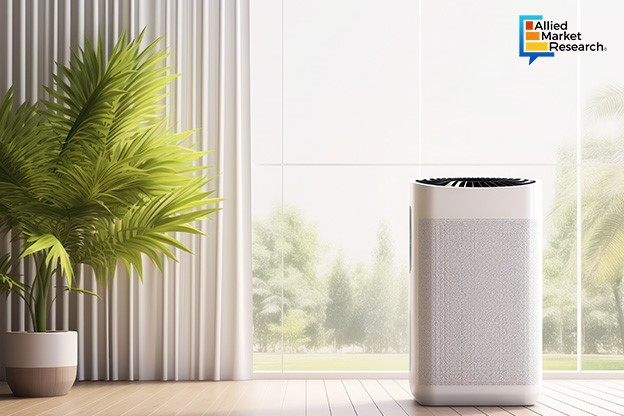How Has Emphasis on Energy Efficiency and Smart Technologies Transformed the Air Dehumidifier Industry?

31 Jul
2024
Key Takeaways:
- Introduction
- The increased emphasis on energy efficiency
- The integration of IoT technology in air dehumidifiers
Air humidifiers are electronic devices that maintain optimal humidity levels in indoor residential or commercial spaces. The growing disposable incomes of people across the globe and the rising awareness regarding a healthy environment have led to an increase in the demand for various household products and consumer goods like air humidifiers. Furthermore, the advancements in electronics and telecommunication technologies have contributed to a surge in the adoption of such gadgets. Additionally, the enactment of new building regulations in several metropolitan cities, the rising danger of climate change, and the rapid pace of urbanization have acted in the favor of the air dehumidifier industry.
Sustainability and energy efficiency shaping the industry dynamics
The growing impact of global warming and climate change has compelled the consumer goods sector to upgrade and develop products that have a minimal impact on the environment. At the same time, people across the globe, too, are demanding products that reduce the carbon footprint of their everyday living. To align with the changing behavioral patterns, air dehumidifier companies have started using desiccant materials such as advanced polymer composites, silica gel, and activated alumina.
Unlike conventional refrigerant dehumidifiers, these compounds have a higher absorption capacity and are efficient. As a result, the frequency of repair and replacement of these materials goes down. Ultimately, this has made modern air dehumidifiers more durable and reliable, reducing their power consumption. Furthermore, traditional refrigerants have ozone-depleting substances which weaken the stratospheric layer, exposing the Earth to harmful UV radiation. On the other hand, desiccant materials are made from compounds that have no harmful effect on the atmosphere.
Apart from these solutions, electronic companies are also using technologies like heat recovery, advanced control systems, variable speed drives, etc., to streamline the performance of the device and bring down power consumption. The use of recyclable materials to manufacture air humidifiers is also a major trend witnessed in the air dehumidifier industry.
In September 2022, Bry-Air, an industrial dehumidification products supplier, announced the launch of BryShield, an innovative air filtration system. The advanced air dehumidifier is specifically designed to remove gaseous contaminants from server rooms and prevent the corrosion of electronic devices. As per a study, around 75% of micro-electronic failures are caused due to corrosion of the components. Bry-Air has claimed that the product has been designed to address the demands of the IT sector. The launch of this innovative product is expected to significantly expand the company's footprint in the coming years.
Smart technologies and automation for cutting-edge air dehumidifiers
Regular air dehumidifiers work on manual controls which, in certain cases, increase the carbon footprint of residential or industrial spaces due to overuse. Hence, consumer electronics manufacturers have started integrating IoT technologies to make these devices ‘smart’ and remotely controllable. IoT-powered dehumidification systems use sensors and other such technologies for predictive maintenance. This reduces the risk of unexpected breakdowns and brings down the downtime drastically. Moreover, these gadgets can detect the temperature, humidity, dust pollution levels, etc., in the indoor air, and turn off or switch on the system automatically.
Owing to these factors, the demand for smart air dehumidifiers has increased immensely across the globe. While North America held the highest revenue share in 2022, the Asia-Pacific province is predicted to have the fastest growth rate by 2032. The changing climatic conditions, rapid urbanization, evolving lifestyle patterns, and growing disposable incomes are the main factors that have influenced the landscape in these regions. By country, the Indonesia air humidifier industry is anticipated to surge ahead at a CAGR of 7.4% in the 2023-2032 period. The development of advanced dehumidification systems with programmable logic controllers (PLCs) to enhance operational control is projected to play a huge role in the expansion of the industry. Finally, the rising applicability of air dehumidifiers in different end-use sectors such as IT and manufacturing is estimated to open new avenues of growth.
To conclude, the air dehumidifier industry is expected to witness major growth in the coming period owing to the rising shift toward sustainability and energy efficiency. Moreover, the use of desiccant materials, the integration of IoT technology, and the launch of innovative products by major companies are expected to strengthen the position of the sector.
For a comprehensive study on the leading growth drivers and investment opportunities in the landscape, feel free to contact us.

Akhilesh Prabhugaonkar
Author's Bio- Akhilesh Prabhugaonkar holds a bachelor’s degree in Electronics Engineering from the reputed Vishwakarma Institute of Technology. He has a special interest in the fields of forensics, world history, international relations and foreign policy, sports, agriculture, astronomy, security, and oceanography. An ardent bibliophile and melophile, Akhilesh loves to write on topics of his interest and various other societal issues. This love for writing made him enter the professional world of content writing and pursue his career in this direction.
Avenue: Entire Library membership of Allied Market Research Reports at your disposal
- Avenue is an innovative subscription-based online report database.
- Avail an online access to the entire library of syndicated reports on more than 2,000 niche industries and company profiles on more than 12,000 firms across 11 domains.
- A cost-effective model tailored for entrepreneurs, investors, and students & researchers at universities.
- Request customizations, suggest new reports, and avail analyst support as per your requirements.
- Get an access to the library of reports at any time from any device and anywhere.
Related Post
-
How are Submarine Cables Transforming Global Connectivity with Enhanced User Experience?
-
Endoscopy Procedures: Transformations in Techniques and Applications
-
AI-Powered Video Analytics: How the Product Actually Works for enterprises
-
Painting Robots: Transforming Precision Coating and Creative Applications
-
Innovations in Pharmacovigilance Systems Advancing Patient Safety
-
Understanding Edge Security: Keeping Data Safe Near the Source
-
Exploring the Use and Advancements of 3D Laser Scanners in Professional Applications
-
Reinforcing Industrial Controls with Smarter Tools and Training








